Home | Tours | Trip Reports | News | Team | Calendar | Links | Contact | Store | Mailing List

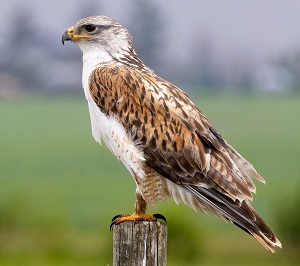 CANADA:
CANADA:ALBERTA
May 27 - June 5, 2027
Plus Banff & Jasper Extension
June 5 - 10, 2027
Contact [email protected] to reserve your space!
Trip Cost> Registration Form>
Terms/Cancellation Policies>
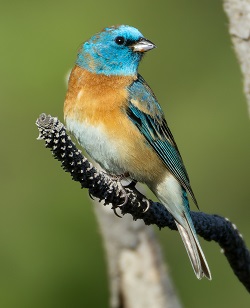 Alberta is a bird watcher's paradise, with more than 430 species recorded across its diverse landscapes. Nestled in Western Canada, this prairie province is a breathtaking mosaic of habitats: from the sweeping golden grasses of the eastern Great Plains to the towering majesty of the Rocky Mountains in the west. Alberta encompass the sun-scorched badlands of the southeast, where ancient secrets lie buried beneath rugged terrain, and the sprawling boreal forests of the north, alive with bird song.
Alberta is a bird watcher's paradise, with more than 430 species recorded across its diverse landscapes. Nestled in Western Canada, this prairie province is a breathtaking mosaic of habitats: from the sweeping golden grasses of the eastern Great Plains to the towering majesty of the Rocky Mountains in the west. Alberta encompass the sun-scorched badlands of the southeast, where ancient secrets lie buried beneath rugged terrain, and the sprawling boreal forests of the north, alive with bird song.
The diverse ecosystems of Alberta aren’t just stunningly beautiful—they’re a paradise for bird watchers. Whether you're chasing the call of a Yellow Rail or scanning the skies for soaring raptors, Alberta’s natural wonders set the stage for an unforgettable birding adventure.
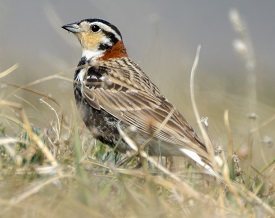 Our itinerary includes and exploration of Alberta's boreal forest, where we’ll be on the lookout for eastern warblers that reach their western limits here, like Blackburnian, Canada, and even Connecticut Warbler which have some of their highest density here. We might also find northern specialties like Nelson’s Sparrow, and if we’re lucky, hear the distinctive ticking call of a Yellow Rail.
Our itinerary includes and exploration of Alberta's boreal forest, where we’ll be on the lookout for eastern warblers that reach their western limits here, like Blackburnian, Canada, and even Connecticut Warbler which have some of their highest density here. We might also find northern specialties like Nelson’s Sparrow, and if we’re lucky, hear the distinctive ticking call of a Yellow Rail.
Out on the prairies, we’ll search for classic grassland birds such as Chestnut-collared and Thick-billed Longspurs, Baird’s and Brewer’s Sparrows, Sprague’s Pipit, and the largest North American buteo, the Ferruginous Hawk.
In the Rockies, we’ll enjoy beautiful scenery while looking for Calliope and Rufous Hummingbirds, Lazuli Buntings, Black-headed Grosbeaks and more. The foothills offer the integration zone for many species and subspecies where western birds meet the eastern. Here, we have a chance to see the iconic Great Gray Owl quietly hunting along the roadside.
Join us on an unforgettable adventure to discover
the remarkable birds and landscapes of Alberta!!
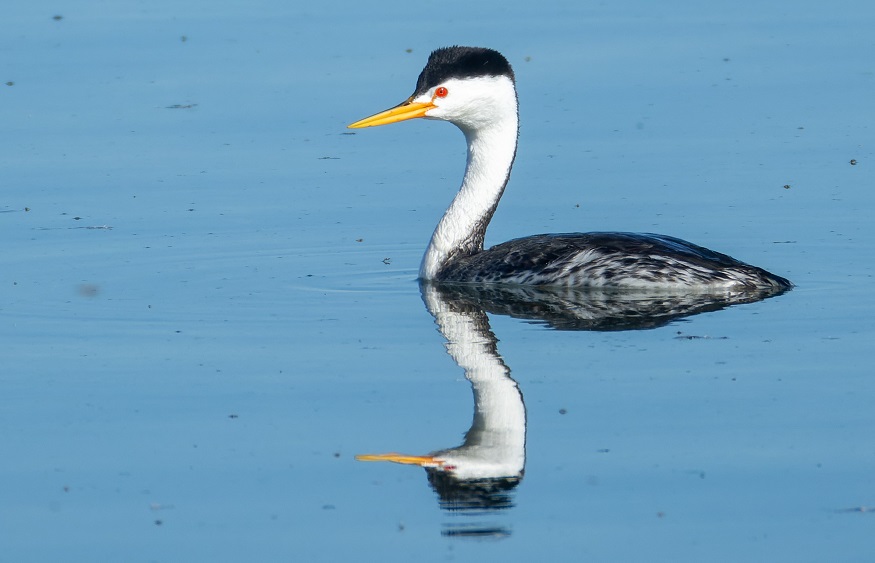
Trip Cost & Travel Planning> Registration Form> Tour Registration, Terms, Cancellation Policies>
Photos: Ferruginous Hark, Lazuli Bunting, Chestnut-collared Longspur, Clark's Grebe by Gavin McKinnon.
ITINERARY
Day 1: Arrive in Edmonton, Alberta
Plan to arrive meet at Edmonton International Airport (Airport code: YEG) today. We will meet for dinner and an orientation session this evening.
May 28: Edmonton to Cold Lake via Elk Island and Whitford Lake
We’ll begin our tour with an early departure from Edmonton, heading east toward Elk Island National Park, a UNESCO designated Biosphere Reserve just 35 minutes east of Edmonton. This protected area is rich in wildlife, and we’ll spend the morning birding the park’s mixed woods, wetlands, and open meadows. Expect good chances at seeing species like Red-necked Grebe, White-faced Ibis, Loggerhead Shrike, Brewer's Blackbird, Yellow-bellied Sapsucker, Mountain Bluebird (Photo Gina Nichol), Cinnamon Teal, and Bison and perhaps even a Moose. From there, we’ll head east to Whitford Lake, a productive wetland where we’ll search for waterfowl, shorebirds, and grassland species. Eared and Horned Grebes, Canvasbacks, Black Terns, and LeConte’s Sparrows are all possible here.
In the afternoon, we’ll continue our journey northeast through rolling farmland and forest toward the town of Cold Lake, arriving in the evening to settle in for the night. This area places us at the doorstep of one of Alberta’s premier birding destinations.
May 29: Birding Cold Lake PP and Bonnyville area
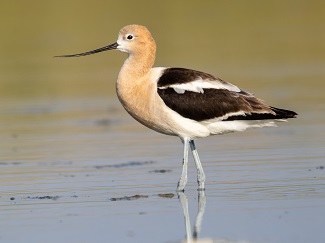 We’ll spend the morning exploring the rich boreal habitats around Cold Lake Provincial Park, one of Alberta’s most productive birding areas. The park’s mix of mature forest, lakeshore, and wetlands support a wide diversity of species. We’ll target boreal specialties like Blackburnian, Orange-crowned Warbler, Tennessee, Cape May, and Canada Warblers among others here. On the water, we'll scan for Common Loon, Western Grebe, California Gull, and American White Pelican, and with a cold front Sabine’s Gulls and Pacific Loons can be seen on this large inland lake.
We’ll spend the morning exploring the rich boreal habitats around Cold Lake Provincial Park, one of Alberta’s most productive birding areas. The park’s mix of mature forest, lakeshore, and wetlands support a wide diversity of species. We’ll target boreal specialties like Blackburnian, Orange-crowned Warbler, Tennessee, Cape May, and Canada Warblers among others here. On the water, we'll scan for Common Loon, Western Grebe, California Gull, and American White Pelican, and with a cold front Sabine’s Gulls and Pacific Loons can be seen on this large inland lake.
In the afternoon, we’ll make our way to Charlotte Lake and Jesse Lake, excellent sites for migrant shorebirds like Black-bellied Plover, White-rumped Sandpiper and Stilt Sandpipers. Breeding shorebirds such as Black-necked Stilts and American Avocets (Photo: Gavin McKinnon) will also be found here along with large numbers of Franklin’s Gulls and Yellow-headed Blackbirds. In the nearby Moose Lake Provincial Park, we will look for Olive-sided Flycatchers, Boreal Chickadee, and potentially Black-backed Woodpecker.
May 30: Primrose Lake Road to Hanna
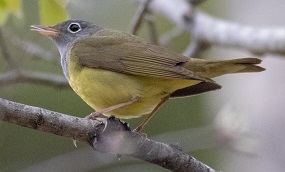 This morning, we’ll explore the western side of Cold Lake, birding along Primrose Lake Road, a quiet, forest-lined route that winds through rich boreal habitat. This area offers an excellent opportunity to see Connecticut Warbler (Photo: Gavin McKinnon), Nashville Warbler, and Palm Warbler. We’ll also keep listening for Yellow-bellied Flycatcher, which can sometimes be found calling from deep within spruce bogs. It’s also worth watching the treetops here, Bonaparte’s Gulls and Greater Yellowlegs are occasionally spotted perched in tall spruces, a surprising sight and a glimpse into their unique their breeding behavior.
This morning, we’ll explore the western side of Cold Lake, birding along Primrose Lake Road, a quiet, forest-lined route that winds through rich boreal habitat. This area offers an excellent opportunity to see Connecticut Warbler (Photo: Gavin McKinnon), Nashville Warbler, and Palm Warbler. We’ll also keep listening for Yellow-bellied Flycatcher, which can sometimes be found calling from deep within spruce bogs. It’s also worth watching the treetops here, Bonaparte’s Gulls and Greater Yellowlegs are occasionally spotted perched in tall spruces, a surprising sight and a glimpse into their unique their breeding behavior.
After a productive morning, we’ll begin heading south toward Kehewin, looking for Broad-winged Hawk along the drive. Here we will make a quick stop for Philadelphia Vireo, Veery, Rose-breasted Grosbeak, Ruby-throated Hummingbird and maybe Great Crested Flycatcher. After lunch we will begin the drive south to Hanna where we will spend one night.
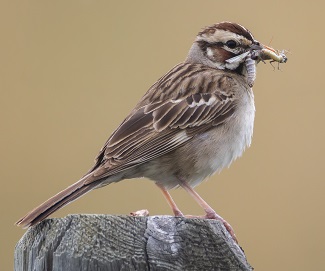 May 31: Dinosaur Provincial Park & Kinbrook Island Provincial Park
May 31: Dinosaur Provincial Park & Kinbrook Island Provincial Park
This morning, after some local birding near Hanna we’ll visit the spectacular Dinosaur Provincial Park, a UNESCO World Heritage Site known for its striking badlands landscape and incredible fossil beds. Beyond the geology, it’s also a unique birding hotspot, where prairie meets desert-like terrain. We’ll explore the coulees and scrubby slopes in search of Rock Wren, Yellow-breasted Chat, Lark Sparrow (Photo: Gavin McKinnon), and Brown Thrasher. The scenery alone makes this a highlight of the trip, and the birding adds another layer of excitement.
After lunch, we’ll head south to Kinbrook Island Provincial Park, located on the shores of Lake Newell. This site features extensive marshes, open water, and wetland edge habitat, perfect for an afternoon of waterbird watching. We’ll search for Western Grebes, American Avocets and a variety of ducks, with chances for rarer species depending on water levels. In past years, this park has hosted a family of Long-eared Owls. We'll stay overnight in nearby Brooks, well-positioned for the next leg of our journey.
June 1: Grasslands & Wetlands near Brooks drive to Pincher Creek
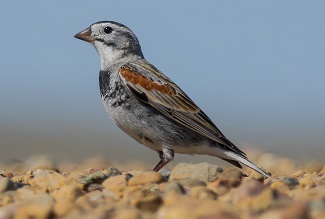 We’ll begin the day exploring some of the last remaining native grasslands near Brooks, a vital refuge for prairie birds in a rapidly changing landscape. This region supports several iconic and hard-to-find species, and we’ll be searching for Thick-billed Longspur (Photo: Gavin McKinnon), Chestnut-collared Longspur, Sprague’s Pipit, Baird’s Sparrow, and Brewer’s Sparrow we also have a very good chance to see Pronghorns. With some luck, we may also spot a Burrowing Owl, at a burrow while Ferruginous Hawks soar overhead.
We’ll begin the day exploring some of the last remaining native grasslands near Brooks, a vital refuge for prairie birds in a rapidly changing landscape. This region supports several iconic and hard-to-find species, and we’ll be searching for Thick-billed Longspur (Photo: Gavin McKinnon), Chestnut-collared Longspur, Sprague’s Pipit, Baird’s Sparrow, and Brewer’s Sparrow we also have a very good chance to see Pronghorns. With some luck, we may also spot a Burrowing Owl, at a burrow while Ferruginous Hawks soar overhead.
In the afternoon, we’ll shift habitats and visit nearby wetlands, which can be excellent for waterbirds. We’ll watch for American Bittern hiding in the reeds and keep our scopes ready in case a Clark’s Grebe is present among the Western Grebes on larger bodies of water.
Following our birding stops, we’ll make the drive southwest toward Pincher Creek, situated near the base of the southern Rocky Mountains. As we approach, the landscape begins to shift dramatically, setting the stage for a new suite of birds and habitats in the coming days.
June 2: Birding Waterton Lakes National Park
 Today we’ll spend a full day exploring the incredible diversity of Waterton Lakes National Park, where prairie, montane forest, and alpine habitats all converge. Our morning will begin at Cameron Lake, a scenic subalpine site where we’ll search for Steller’s Jay, Pacific Wren, and Townsend’s Warbler in the dense coniferous forest. Along the creek edges, we’ll look for nesting American Dippers, and with luck, we may spot a Harlequin Duck among the more numerous Barrow’s Goldeneyes.
Today we’ll spend a full day exploring the incredible diversity of Waterton Lakes National Park, where prairie, montane forest, and alpine habitats all converge. Our morning will begin at Cameron Lake, a scenic subalpine site where we’ll search for Steller’s Jay, Pacific Wren, and Townsend’s Warbler in the dense coniferous forest. Along the creek edges, we’ll look for nesting American Dippers, and with luck, we may spot a Harlequin Duck among the more numerous Barrow’s Goldeneyes.
In areas affected by fire a decade ago, we’ll explore burned forest for American Three-toed and Black-backed Woodpeckers. Lewis’s Woodpeckers have also nested here in recent years. Throughout the day, we’ll encounter a variety of mountain passerines, including Lazuli Bunting, Fox Sparrow, and MacGillivray’s Warbler. The area is also good for hummingbirds, with chances of seeing both Rufous and Calliope (Photo: Gavin McKinnon). In the wetland and marshy areas, we’ll look for Willow Flycatcher, and listen for Virginia Rail, and may even come across Sandhill Cranes. With its mix of spectacular scenery and rich birdlife, Waterton promises to be one of the most memorable days of the tour.
Barrow's Goldeneyes by Steve Bird.
June 3: Castle Provincial Park to Frank Lake
This morning, we’ll head back into the mountains, this time to the scenic and less-traveled Castle Provincial Park. Our first stop will be in the small town of Beaver Mines, a reliable spot for Cassin’s Finch and Evening Grosbeak (Photo: Gina Nichol), often seen at feeders or in the surrounding conifers.
From there, we’ll venture deeper into the park, where mixed coniferous forests provide habitat for a trio of flycatchers: Dusky, Hammond’s, and Western Flycatcher. The rich montane ecosystem also offers chances for other mountain birds, and with luck, we may spot species like Western Tanager or Western Warbling Vireo as we explore.
By late morning, we’ll begin our journey north. On the way, we’ll make a key stop at some cliffs west of Nanton, where Prairie Falcons nest and some years these same cliffs host a family of Golden Eagles.
Our final stop of the day will be at Frank Lake, one of southern Alberta’s premier wetlands. Here, we’ll enjoy an impressive mix of waterbirds, including White-faced Ibis, Black-necked Stilt, Eared Grebe, and Western Grebe. And visit a nesting colony of California Gulls and American White Pelicans. Night in Calgary.
June 4: Water Valley Area
On our final full day of birding, we’ll head northwest of Calgary to the Water Valley area, a mix of boreal-edge forest, wet meadows, and quiet back roads that offer excellent birding in a peaceful setting. Our top target today is the elusive and majestic Great Gray Owl (Photo: Gavin McKinnon), which nests in this region and is sometimes seen hunting along the roadside.
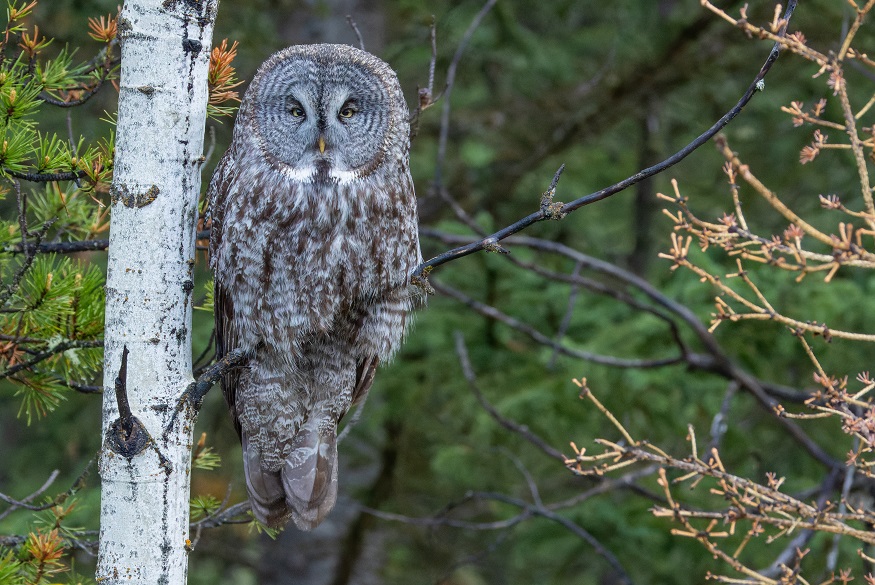
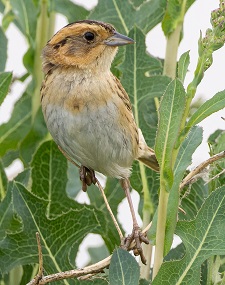 Along the wetland edges, we’ll search for secretive species like Nelson’s Sparrow (Photo: Gavin McKinnon), LeConte’s Sparrow, and, if we’re lucky, the rarely seen Yellow Rail. These birds are highly dependent on the right water levels and vegetation, so sightings can vary by year. In the surrounding mixed woods, we may find Cape May Warblers, potentially new for the trip list, as well as Blue-headed Vireo, Mountain Bluebird, and the often-overlooked Solitary Sandpiper. After a full day of birding in this rich and varied landscape, we’ll return to Calgary for our final night of the tour.
Along the wetland edges, we’ll search for secretive species like Nelson’s Sparrow (Photo: Gavin McKinnon), LeConte’s Sparrow, and, if we’re lucky, the rarely seen Yellow Rail. These birds are highly dependent on the right water levels and vegetation, so sightings can vary by year. In the surrounding mixed woods, we may find Cape May Warblers, potentially new for the trip list, as well as Blue-headed Vireo, Mountain Bluebird, and the often-overlooked Solitary Sandpiper. After a full day of birding in this rich and varied landscape, we’ll return to Calgary for our final night of the tour.
June 5: Departures from Calgary International Airport (YYC) or continue on Rockies extension
Contact [email protected] to reserve your space!
Canadian Rockies Extension - Banff & Jasper
June 5 - 10, 2027
June 5: Brown-Lowery to Sibbald Creek Trail
We’ll begin our journey south of Calgary at Brown-Lowery Provincial Park, composed of foothills forest and mixed shrubland that’s known for its population of American Three-toed Woodpeckers, our top target this morning. The park also supports a nice mix of other songbirds, including Ovenbird, Red-eyed Vireo, Western Tanager (Photo: Steve Bir), and Swainson’s Thrush. We'll work the trails slowly, listening for drumming woodpeckers.
In the late morning, we’ll head northwest to Sibbald Creek Trail, another excellent foothills site where we’ll look for species like Willow Flycatcher, MacGillivray's Warbler, Olive-sided Flycatcher, and possibly American Goshawk or Ruffed Grouse.
In the afternoon, we’ll continue west to Canmore, nestled in the Bow Valley, where we’ll settle in for our first night. If time allows, we may explore Policeman’s Creek or another nearby site for evening birding.
June 7: Banff
We begin the day birding at the Cave and Basin Marsh in Banff, a truly unique ecological gem shaped by warm thermal waters flowing from Sulphur Mountain. The wetland here offers everything from Cinnamon Teal to sora, to Willow Flycatcher, to Yellow-headed Blackbird, and more. The habitat here should be productive with possibilities for Orange-crowned Warbler, Townsend's Warbler, Cassin's Vireo, and more. Elk, deer, and coyotes frequent the area. And, if we are really lucky and observant, we may see wolves or bears
From there, we’ll head to the Fenland Nature Trail in Banff, a quiet forested area offering a good chance to spot American Three-toed Woodpecker. This trail also supports species like Least Flycatcher, Pacific Wren, and Boreal Chickadee. After lunch, we will visit the town of Exshaw, where we can see species like Rufous Hummingbird and Violet-green Swallow.
June 8: Banff to Jasper via the Icefields Parkway
Today we travel north through Lake Louise toward Jasper along the spectacular Icefields Parkway, one of the most scenic drives in Canada. We’ll stop at the Columbia Icefields, nestled between Jasper and Banff National Parks, where open alpine and shrubby habitat give us a chance to see Fox Sparrow and the “timberline” subspecies of Brewer’s Sparrow. We'll keep eyes up as well for perhaps a Golden Eagle soaring above, or a Peregrine Falcon or Barrow’s Goldeneyes flying over. And we'll scan the landscape for Hoary Marmot and perhaps hear why it is called the “whistle pig”, the tiny Pika, and Mountain Goats & Bighorn Sheep, often seen scaling cliffs and steep slopes.
As we continue north, we’ll keep an eye out for large mammals such as Black and Grizzly Bear and Elk (Photo: Steve Bird) along the roadside. In the evening, we’ll enjoy a fresh BBQ dinner in the field at the Maligne Overlook, where we’ll watch for Black Swifts as they return to their nesting cliffs for the night.
June 9: Birding Jasper and the Alpine
We begin the day with a ride up the Jasper SkyTram to the summit of Whistlers Mountain, where we’ll explore alpine and subalpine habitats aroung 7400 ft and panoramic vistas of Jasper town, Athabasca River Valley, and surrounding peaks. Here, we’ll search for White-tailed Ptarmigan (Photo: Gavin McKinnon) and Gray-crowned Rosy-Finch (Photo: Gavin McKinnon), and with a bit of luck, Golden-crowned Sparrow near the tree line. After a morning immersed in the high country, we’ll return to Jasper for lunch.
In the afternoon, we’ll explore local forest and burn areas, targeting species like Hammond’s Flycatcher and scanning the burned snags for woodpeckers such as American Three-toed and Black-backed Woodpecker. Night in Hinton.
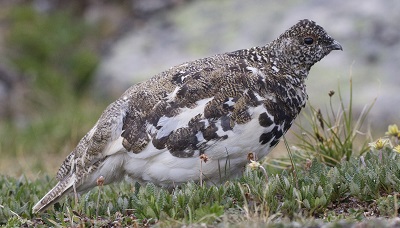
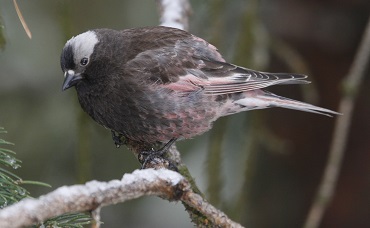
June 10: Hinton to Edmonton and Departure
This morning we begin our journey east from Hinton to Edmonton, passing through stretches of boreal forest along the way. As we travel, we’ll keep watch for familiar species such as Pileated Woodpecker, Western Tanager, and other forest songbirds. We aim to arrive in Edmonton by early afternoon to allow time for departures and onward travel from Edmonton International Airport (YEG)
Contact [email protected] to reserve your space!
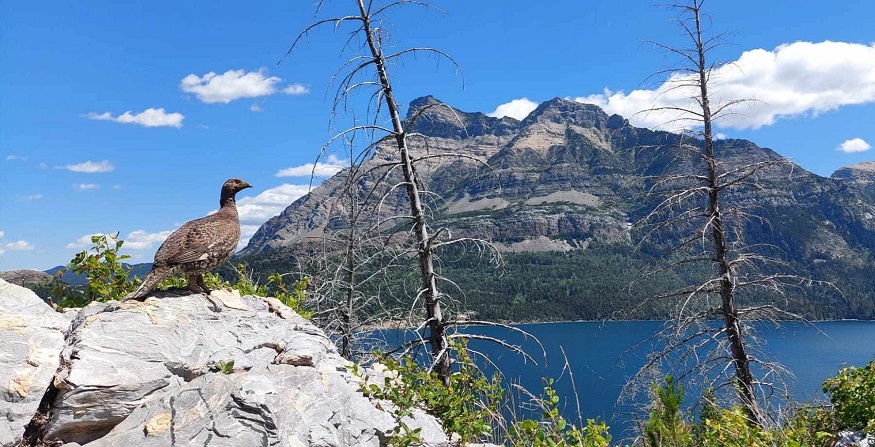
Alberta scene by Asher Warkentin.
Leaders: Gina Nichol, Steve Bird, & Gavin McKinnon
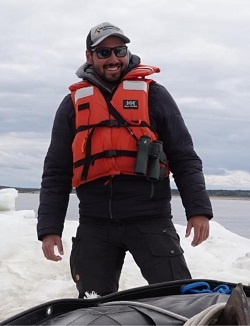 Gavin McKinnon
Gavin McKinnon
From an early age, Gavin developed a deep fascination for birds after he visited Point Pelee National Park on a weekend trip with family. Since then, he has traveled extensively in Canada and to numerous locations in the tropics and around the globe in search of unique birding opportunities. In 2022 Gavin founded Meadowlark Birding Tours with the goal of sharing his passion for birds with others. After high school, he studied Renewable Resource Management at Lethbridge College and briefly worked in environmental consulting. In addition to leading tours, Gavin is actively involved in the local birding community, serving as a volunteer eBird reviewer.
Trip Cost & Travel Planning> Registration Form>
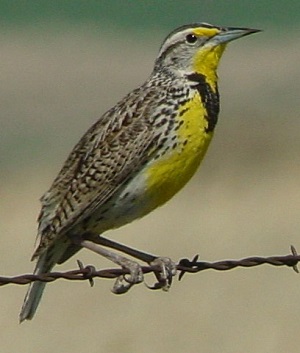 ALBERTA ALBERTAMay 27 - June 5, 2027 Plus Banff & Jasper Extension June 5 - 10, 2027 Registration Form> Contact [email protected] to reserve your space! MAIN TOUR PRICE: **$6795 per person based on double occupancy and a group of 6 pax from Edmonton, Alberta (Airport code: YEG) . With less than 6 pax, a small group supplement will be charged. Note that the main tour begins in Edmonton and ends in Calgary (Airport code: YYC). **Denotes provisional pricing. Price will be honored for those booking while provisional price is posted. Single supplement, Main tour: **$1495 per person, subject to availability. **Provisional pricing. Price will be honored for those booking while provisional price is posted. BANFF & JASPER EXTENSION: $TBA per person based on double occupancy and a group of 6 pax from Calgary, Alberta (Airport code: YYC) . Note that the extension begins in Calgary and ends in Edmonton (Airport code: YEG) Single supplement: $TBA per person, subject to availability. Please inquire. We are awaiting pricing on the extension. Deposit: $1000.00 per person. Note: Tour deposits can be paid by credit card via PayPal. Use this link to make your credit card payment. Please advise [email protected] when you have made payment. Included in cost: Accommodation in double / twin en suite rooms with full board, group transportation on arrival, detailed pre-trip materials and checklists, services of local guide and tour leaders throughout the trip. Not included: Flights to and from Edmonton and Calgary, luggage charges, insurance, drinks, tips, and items of a personal nature. Also, any and all costs arising from pandemic or Covid-19 related issues are not included in the tour cost and are the sole responsibility of the traveler. These include, among others, the costs of Covid treatment, hospitalization, medical fees, transport, meals and accommodation in case of illness or quarantine, and the costs of any Covid tests needed before, during and after the tour.
Check or bank transfer are preferred but credit card payments are possible (surcharges of up to 5% are added depending on amount to cover credit card company fees). Final payment is due January 27, 2027.
**Please
note: Tour prices
are based on quoted
costs from ground
operators (in
their local currency),
estimated fuel
costs, and the
rate of exchange
the time of itinerary
publication. The
erratic nature
to global financial
markets makes
it difficult to
predict changes
in costs and foreign
currency exchange
rates over the
long term. Since
tours are priced
well in advance
of the actual
operation of the
tour, tour costs,
fuel costs and
exchange rates
can change, sometimes
drastically. Depending
on the extent
of such changes,
it may be necessary
to implement a
surcharge on this
tour. If a surcharge
is necessary,
every effort will
be made to minimize
the amount. Cancellations
and Refunds:
TRIP INSURANCE:
|
Questions? Contact Gina Nichol at gina@sunrisebirding.com